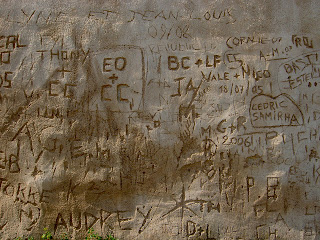
On my last day in Corsica Ellen’s family dropped me and Emily off in Saint-Florent, a little spa town on the Cap Corse, the promontory thumb that rises from Corsica’s fist. We walked up to the Genoese citadel which was surrounded by banks of shoulder-high yellow flowers and palm trees, and carved with lovers’ names. The town must be hellish in summer, but the tourists were only just arriving and the restaurants along the quay were half empty.


We sat looking at the gin-palaces and feeding breadcrumbs to sparrows and collared doves, and then wandered up a deserted street out of the town in search of the Cathédrale du Nebbiu. One of only two surviving Pisan cathedrals in Corsica, it was abandoned because of the malarial swamp it sits in, and now stands aloof outside the town, surrounded by fields. It is blocky and spare, with a slate roof, warm limestone walls and crisp Romanesque capitals with a snake and what looked like a boar, but was probably a lion, above the west door. They are restoring the roof and apse, but as it was a Sunday it was empty and we went in.


A swallow was flitting through the gloom and we were temporarily blinded by the glare from outside. It was like a mirror image of Bede’s sparrow:
‘Oh King, when we compare the present life of man with that time which is unknown to us, it seems to me like the swift flight of a single sparrow through the banqueting hall where you sit at supper in winter with your thegns and counsellors. In the midst there is a good fire; outside, the storms of rain and snow are raging. The sparrow flies swiftly in at one door and out at another. Whilst he is within, he is safe from the wintry storm; but after a few moments of comfort he vanishes from sight into the dark winter from which he came. Even so, man appears on earth for a little while, but of what went before, or what is to follow, we know nothing.’
Βede, Ecclesiastical History, II.13
There was some upsetting baroque stuff going on in the sanctuary, but I averted my eyes and looked at the lovely twelfth-century capitals: my pictures didn’t come out in the dark, but one was a coil like an ammonite, with a toothed, maned beast on the other side. Just as we were leaving we saw a glass coffin in the corner, with a reclining corpse leering blindly out, dressed in hilarious eighteenth-century pantaloons. There was no indication of who he might be, but the internet has since told me that in 1770 the Bishop of Nebbiu got in a sulk about his church’s lack of relics and got the pope to dredge up a Roman corpse from the catacombs to baptise as St. Flor and display in the church. Every three years, on Pentecost Monday, the villagers process around the town with him. Even for a relic afficionado like me, he was quite frightening: Emily has obviously not been in enough Catholic churches to appreciate desiccated corpses and she left rather swiftly.

We spent the rest of the day eating a huge lunch (brocciu fritters, brocciu-stuffed sardines and profiteroles for Emily, gambas with chestnuts, rigatoni with langoustines and lobster sauce, and fiadone - the delicious brocciu baked cheesecake and national dessert of Corsica - for me) and reading on the beach. A perfect Corsican day to end my time here: good company, close encounters with Catholicism, sun, sea and sand, and huge quantities of food.




No comments:
Post a Comment